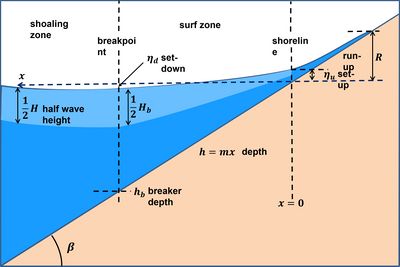Wave run-up
Definition of Wave run-up:
Wave run-up is the maximum onshore elevation reached by waves, relative to the shoreline position in the absence of waves.
This is the common definition for Wave run-up, other definitions can be discussed in the article
|
Notes
Wave run-up is the sum of wave set-up and swash uprush (see Swash zone dynamics) and must be added to the water level reached as a result of tides and wind set-up (Fig. 1). Wave run-up on a beach is generally due to so-called swash bores: the uprush of waves after final collapse on the beach. Wave run-up is an important parameter for assessing the safety of sea dikes or coastal settlements.
By waves is meant: waves generated by wind (locally or on the ocean) or waves generated by incidental disturbances of the sea surface such as tsunamis, seiches or ship waves. Wave run-up is often indicated with the symbol [math] R [/math].
For waves collapsing on the beach, a first order-of-magnitude estimate is given by the empirical formula of Hunt (1959) [1][2][3],
[math]R \sim \eta_u + H \xi , [/math]
where [math]\eta_u \sim 0.2 H[/math] is the wave set-up, [math]H[/math] is the offshore significant wave height and [math]\xi[/math] is the surf similarity parameter,
[math]\xi = \Large\frac{ m}{\sqrt{H/L}}\normalsize = T \, m \, \Large\sqrt{\frac{g}{2\pi H}}\normalsize , \qquad (2)[/math]
where [math]L = g T^2/(2 \pi)[/math] is the offshore wave length, [math]m = \tan \beta[/math] is the beach slope and [math]T[/math] is the wave period. The horizontal wave incursion is approximately given by [math] R / m[/math].
Many other empirical formulas have been proposed for the run-up. A popular formula for the run-up [math] R_2[/math] exceeded by only 2 % of the waves has been developed by Stockdon et al. (2006[4]), based on a large dataset:
[math] R_2 = 1.1 \; (\eta_u + 0.5 \sqrt{S_w^2 + S_{ig}^2} \, ) , \qquad \xi \ge 0.3 , \qquad R_2= 0.043 \; \sqrt{HL} , \qquad \xi \lt 0.3 , \qquad (3) [/math]
where [math]\eta_u = 0.35 H \xi[/math] is the wave set-up, [math]S_w=0.75 H \xi[/math] is the swash uprush related to incident waves and [math]S_{ig}=0.06 \sqrt{HL}[/math] is the additional uprush related to infragravity waves. The factor 1.1 takes into account the non-Gaussian distribution of run-up events.
From an inventory of run-up formulas by Gomes da Silva et al. (2020[5]), it appears that for steep beaches ([math] m \gt 0.1[/math]) the run-up increases with increasing beach slope (approximately linear dependance[6]), while for gently sloping dissipative beaches ([math] m \lt 0.1[/math]) the dependence on beach slope is weak or absent[6][4]. In these latter cases, run-up is dominated by infragravity waves, that yield a small run-up that increases with increasing wave height (approximately linear dependence[7][8]). Field observations[9] and numerical models[10] also point to a dependence of infragravity swash on the frequency spread and the directional spread of incident waves. The largest infragravity swash was observed for incident waves with a small directional spread and a large frequency spread.
In cases where the backshore berm or foredune of dissipative sandy beaches is artificially protected with gravel or cobbles, the run-up [math] R_2[/math] exceeded by only 2 % of the waves when the water level during storms reaches higher than the toe of the cobble berm revetment, can be estimated from the approximate empirical formula[11]
[math] R_2 \approx 4.14 \, h_{toe} m_{berm} +0.66 , \qquad (4) [/math]
where [math]h_{toe}[/math] is the water depth at the toe of the berm and [math]m_{berm}[/math] is the berm slope.
The general applicability of empirical formulas of run-up based on simple parametric representations of beach and shoreface is limited due to the influence of the more detailed characteristics of the local shoreface bathymetry. This is similar to the limited applicability of empirical formulas for the wave set-up, which is a substantial component of the run-up. Accurate estimates of the wave run-up require in-situ observations or detailed numerical models.
Related articles
References
- ↑ Hunt, I.A. 1959. Design of seawalls and breakwaters. J. Waterw. Harbors Division ASCE 85: 123–152
- ↑ Holman, R.A. and Sallenger, A.H. 1985. Setup and swash on a natural beach. J. Geophys. Res. 90: 945–953
- ↑ Atkinson, A.L., Power, H.E., Moura, T., Hammond, T., Callaghan, D.P. and Baldock, T.E. 2017. Assessment of runup predictions by empirical models on non-truncated beaches on the south-east Australian coast. Coast. Eng. 119: 15–31
- ↑ 4.0 4.1 Stockdon, H.F., Holman, R.A., Howd, P.A. and Sallenger, A.H. 2006. Empirical parameterization of setup, swash, and runup. Coast. Eng. 53: 573–588
- ↑ Gomes da Silva, P., Coco, G., Garnier, R. and Klein, A.H.F. 2020. On the prediction of runup, setup and swash on beaches. Earth-Science Reviews 204, 103148
- ↑ 6.0 6.1 Nielsen, P. and Hanslow, D.J. 1991. Wave runup distributions on natural beaches. J. Coast. Res. 7: 1139–1152
- ↑ Ruessink, B.G., Kleinhans, M.G. and Van Den Beukel, P.G.L. 1998. Observations of swash under highly dissipative conditions. J. Geophys. Res. 103: 3111–3118
- ↑ Ruggiero, P., Holman, R. A. and Beach, R. A. 2004. Wave run-up on a high-energy dissipative beach. J. Geophys. Res. 109, C06025, doi:10.1029/2003JC002160
- ↑ Matsuba, Y. and Shimozono, T. 2021. Analysis of the contributing factors to infragravity swash based on long-term observations. Coastal Engineering 169, 103957
- ↑ Guza, R.T. and Feddersen, F. 2012. Effect of wave frequency and directional spread on shoreline runup. Geophys. Res. Lett. 39: 1–5
- ↑ Blenkinsopp, C.E., Bayle, P.M., Martins, K., Foss, O.W., Almeida, L.-P., Kaminsky, G.M., Schimmels, S. and Matsumoto, H. 2022. Wave runup on composite beaches and dynamic cobble berm revetments. Coastal Engineering 176, 104148
